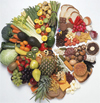
Based on the effect foods may have on individual personality through chemical action on the brain, Hinduism classifies foods in three groups: taamasik, raajasik, and sattvik.
Foods which are dead, partly spoiled, processed, preserved or stale are called taamasik. Such foods create feelings of heaviness, lethargy, irritability and restlessness. Meat is also taamasik when not fresh. Once animal cells die, the process of degeneration and decay begins.
Some meats are, however, raajasik in effect. Foods which are cooked a great deal to increase their taste-appeal, which stimulate the nervous system and speed metabolism up are raajasik. These foods energise, but not in the sense of lending a clear, balanced energy. Raajasik foods tempt one to eat more, focusing the attention on savouring the foods while diverting it from internal signals.
In contrast to the above two categories, those foods which are whole, fresh, natural, of good quality yet mild, neither over- nor under-cooked, are experienced as lending calm alertness and quiet energy. Such foods are called sattvik and are said to nourish the consciousness. Sattvik foods give psychological strength as contrasted with raajasik foods, which supply strength to the muscles. Fresh fruit, vegetables and whole grains are sattvik.
It is also said that saatvic aahaar (wholesome food) is important meaning that it should be prepared with fresh, pure and clean ingredients that have not touched animal substances. It should be accepted and eaten with grace, relishing the taste of each ingredient in every morsel while utilising all five senses (therefore should be eaten by hand – not with cutlery). It should not be kept overnight.
Many non-vegetarian Hindus due to some religious association turn pure vegetarian or fast on particular days of the week. Some believe in fasting or consuming a pure vegetarian diet on certain days of the Hindu calendar months (purnima, ekadasi, shivratri, karwa chauth) whereas many others turn vegetarian during Navaratri or for the entire month of Shravan. The basis for this is vrata or sacrifice to attain spiritual advancement, during which time the person is required to keep the body clean by observing a pure vegetarian diet, celibacy, truthfulness and forbearance.
In September 2021 a Sattvik Council Certification scheme was launched by a company in New Delhi. On the lines of Halal (for followers of Islam) and Kosher (for those of Jewish faith) certifications, the Sattvik certification would be used for 4 types of foods: Sattvik Sattvam, Sattvik Vegetarian, Sattvik Vegan and Sattvik Jain. The company aims to certify approximately 1 million establishments, including kitchens, hotels, products and textiles by 2025.
Soon after in November 2021 the Sattvik Council of India said in a statement that the Indian Railway Catering and Tourism Corporation (IRCTC) had begun serving sattvik certified food in its Katra Vande Bharat Express because the train’s last stop was the Vaishno Devi temple. Some other trains would also be sattvik certified in order to promote vegetarian-friendly travel and IRCTC base kitchens, executive lounges, budget hotels, food plazas, travel and tour packages would also be sattvik certified.
Those using vegetarian and animal products together are excluded from certification. There shouldn’t be any wet market 500 to 800 metres of the kitchen or butchering nearby. Lacto-vegetarian certification is given after DNA tests to check whether the food preparations have any animal content (dairy is allowed but not eggs). The kitchens also need to follow a strict protocol and be vastu-certified.
|